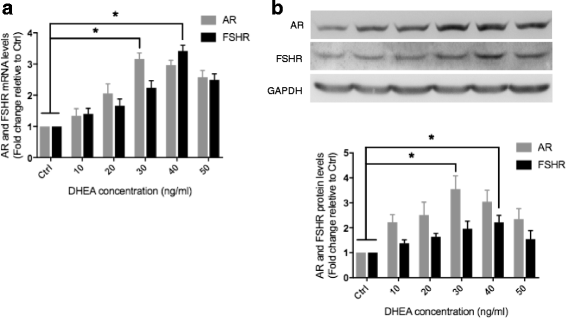The effect of dehydroepiandrosterone supplementation on ovarian response is associated with androgen receptor in diminished ovarian reserve women
- PMID: 28472976
- PMCID: PMC5418866
- DOI: 10.1186/s13048-017-0326-3
The effect of dehydroepiandrosterone supplementation on ovarian response is associated with androgen receptor in diminished ovarian reserve women
Abstract
Background: Diminished ovarian reserve(DOR) is associated with female infertility and poor response to ovarian stimulation. Our objective was to assess the effect of dehydroepiandrosterone(DHEA) on DOR women and to explore whether the improvement of ovarian response after DHEA supplementation was dependent on the expression levels of androgen receptor(AR).
Methods: A prospective cohort study was performed in the Department of Human Reproductive Medicine, Beijing Obstetrics and Gynecology Hospital during August 2014 to August 2016. 103 DOR women who completed the study were divided into the DHEA group (n = 53), which received DHEA supplementation (25 mg three times a day) for 8 weeks, and the control group (n = 50), which did not receive DHEA, before the IVF cycles. Serum hormone levels(FSH, LH, E2, T, DHEAs, AMH, INHB), antral follicle count(AFC) and the expression of AR and FSH receptor(FSHR) in granulosa cells(GCs) were measured, meanwhile ovarian response parameters and IVF outcomes were compared. The GCs from another 36 DOR women were cultured with different concentrations of DHEA in vitro. Then, we compared the expression of AR and FSHR in GCs according to the different numbers of oocytes retrieved both in DHEA and control group.
Results: In the present study, DHEA supplementation resulted in significantly higher levels of serum T(P = 0.047), DHEAs(P = 0.019) and AR mRNA expression in GCs(P = 0.049). In vitro experiment, the protein and mRNA expression of AR and FSHR in the preovulatory GCs were significantly increased in response to DHEA supplementation(P <0.05). No significant differences were found in ovarian reserve, ovarian response, or IVF outcomes between the two groups. Subgroup analyses showed the levels of AR and FSHR mRNA in GCs were significantly increased in DHEA group with ≥5 oocytes retrieved(P <0.05).
Conclusion: DHEA supplementation can increase the expression of AR in preovulatory GCs both in vivo and in vitro. The selective beneficial effects of DHEA supplementation on ovarian response in DOR women may depend on the increasing expression of AR and FSHR in GCs.
Trial registration: The Chinese Clinical Trial Registry ( ChiCTR-IPR-15006126 ). Retrospectively Registered 19 March 2015.
Keywords: dehydroepiandrosterone/diminished ovarian reserve/androgen receptor/follicle stimulation hormone receptor/in vitro fertilization.
Figures



References
-
- Testing and interpreting measures of ovarian reserve: a committee opinion. Fertil Steril 2015; 103: e9-e17. - PubMed
-
- May-Panloup P, Ferre-L’Hotellier V, Moriniere C, Marcaillou C, Lemerle S, Malinge MC, et al. Molecular characterization of corona radiata cells from patients with diminished ovarian reserve using microarray and microfluidic-based gene expression profiling. Hum Reprod. 2012;27:829–843. doi: 10.1093/humrep/der431. - DOI - PubMed
Publication types
MeSH terms
Substances
LinkOut - more resources
Full Text Sources
Other Literature Sources
Medical
Research Materials

